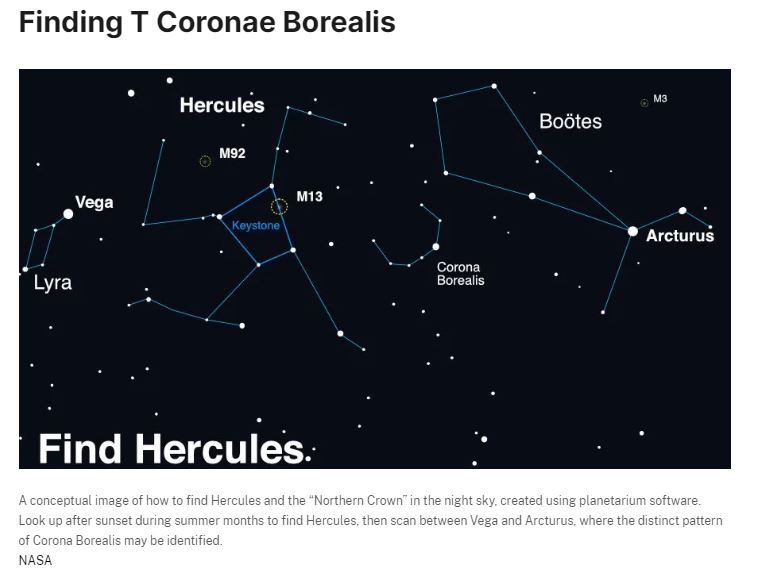In the vast expanse of the cosmos, among the shimmering stars of the Corona Borealis constellation, a spectacular event is poised to capture the imaginations of astronomers around the world. This summer, all eyes will be on T Coronae Borealis, or T CrB, a binary system located some 3,000 light-years from Earth. This unassuming dark spot among the stars is the stage for an impending nova event, one so brilliant that it will be visible to the naked eye.
Dr. Rebekah Hounsell, an assistant research scientist at NASA’s Goddard Space Flight Center, explains the excitement. “It’s a once-in-a-lifetime event that will create a lot of new astronomers out there,” she says. “It’ll fuel the next generation of scientists.”

Get ready for an extraordinary event as T Corona Borealis brightens 1,500 times, becoming visible to the naked eye. Learn the science behind this rare recurrent nova, how to observe it, and why you won’t want to miss this once-in-a-lifetime spectacle
The Dance of the Stars
T CrB is a captivating binary system composed of a white dwarf and a red giant. The white dwarf, a remnant of a dead star, has a mass comparable to our Sun but is roughly the size of Earth. Its partner, the red giant, is an ancient, bloated star that has begun to shed its outer layers. The white dwarf’s intense gravitational pull draws hydrogen from the red giant, forming an accretion disk around the dwarf.
As the hydrogen accumulates on the white dwarf’s surface, pressure and heat build until a thermonuclear explosion erupts, blasting the accumulated material into space. Unlike a supernova, which marks the death of a star, a nova leaves the white dwarf intact, ready to repeat the process. For T CrB, this explosive event happens approximately every 80 years.
Historical Glimpses
The first recorded sighting of T CrB’s nova was in 1217 by Burchard, an abbot in Germany, who described “a faint star that for a time shone with great light.” The most recent eruption was in 1946, and the current behavior of the system suggests another outburst could occur as soon as September 2024.
The Awaited Spectacle
To spot T CrB, look for the Northern Crown, a horseshoe-shaped curve of stars west of the Hercules constellation. The outburst will be brief but dazzling, visible to the naked eye for less than a week.
A Collaborative Cosmic Watch
Dr. Elizabeth Hays, chief of the Astroparticle Physics Laboratory at NASA Goddard, is equally enthusiastic. She highlights the crucial role of amateur astronomers and citizen scientists. “Using social media and email, they’ll send out instant alerts, and the flag goes up. We’re counting on that global community interaction again with T CrB,” she says.
NASA’s Fermi Gamma-ray Space Telescope, along with other missions like the James Webb Space Telescope and the Neil Gehrels Swift Observatory, will observe the event. Ground-based telescopes, including the Very Large Array in New Mexico, will also participate, capturing data across the electromagnetic spectrum.

Unlocking Stellar Secrets
For researchers, T CrB offers a rare opportunity to study nova events up close. “Typically, nova events are so faint and far away that it’s hard to clearly identify where the erupting energy is concentrated,” Hays explains. “This one will be really close, with a lot of eyes on it, studying the various wavelengths and hopefully giving us data to start unlocking the structure and specific processes involved.”
New tools like gamma-ray imagers and IXPE’s polarization capability promise unprecedented insights into the lifecycles of binary systems and the processes driving them.
The Unpredictable Nature of Novae
Dr. Koji Mukai, another astrophysics researcher at NASA Goddard, reminds us of the inherent unpredictability of recurrent novae. “Recurrent novae are unpredictable and contrarian,” he says. “We’ll see how T CrB behaves.”
As the world waits with bated breath, the potential nova event of T Coronae Borealis promises not only a breathtaking spectacle but also a wealth of scientific discovery, inspiring both seasoned astronomers and budding stargazers alike.





